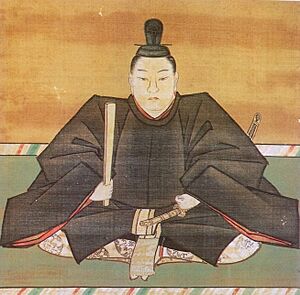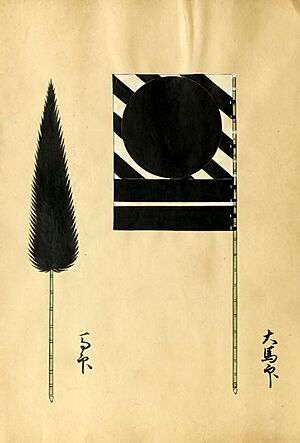Shimazu Yoshihiro facts for kids
Quick facts for kids
Shimazu Yoshihiro
|
|
|---|---|
| 島津 義弘 | |

Shimazu Yoshihiro
|
|
| Head of Shimazu clan | |
| In office 1587–1602 |
|
| Preceded by | Shimazu Yoshihisa |
| Succeeded by | Shimazu Tadatsune |
| Personal details | |
| Born | August 21, 1535 Izaku Castle, Satsuma Province |
| Died | August 30, 1619 (aged 84) |
| Nationality | Japanese |
| Spouses | Hongō Tadataka's daughter Saishō-dono |
| Relations | Shimazu Yoshihisa (brother) Shimazu Toshihisa (brother) Shimazu Iehisa (half-brother) |
| Children | Shimazu Hisayasu Shimazu Tadatsune |
| Parents |
|
| Nicknames | "Shimazu Demon" (Oni-Shimazu) |
| Military service | |
| Allegiance | |
| Rank | Daimyo |
| Unit | |
| Commands | Iino Castle |
| Battles/wars |
|
Shimazu Yoshihiro (島津 義弘, August 21, 1535 – August 30, 1619) was a famous Japanese warrior, or daimyō, from the Sengoku period (a time of many wars in Japan). He was the second son of Shimazu Takahisa and the younger brother of Shimazu Yoshihisa. Yoshihiro was a very skilled general. He played a big part in uniting the island of Kyūshū under the Shimazu clan's rule.
Contents
Early Life and Rise to Power
Yoshihiro was born in Izaku Castle in 1535. He became the lord of Iino Castle. He was a strong leader from a young age.
In 1572, Yoshihiro and Niiro Tadamoto won a big battle against the Itō clan at Battle of Kizaki. Later, in 1578, he and his brothers defeated the Otomo clan at the Battle of Mimigawa.
In 1587, the powerful leader Toyotomi Hideyoshi sent his armies to take control of Kyūshū. Yoshihiro wanted to keep fighting, even after his older brother, Yoshihisa, decided to surrender. After Yoshihisa asked him many times, Yoshihiro finally agreed to stop fighting. It was thought that Yoshihiro became the head of the Shimazu clan after this. However, his brother Yoshihisa still held much of the real power.
Serving Under Hideyoshi
Shimazu Yoshihiro was a loyal and talented general for Toyotomi Hideyoshi. He fought bravely in the Seven-Year War in Korea.
In 1597, Yoshihiro worked with other Japanese generals like Tōdō Takatora and Konishi Yukinaga. Together, they defeated the Korean navy led by Won Kyun.
At the Battle of Sacheon in 1598, Yoshihiro faced a huge Chinese army of 37,000 soldiers. He had only 7,000 men, but he still managed to defeat them!
In the final battle of the war, the Battle of Noryang in 1598, Yoshihiro's goal was to cross the Noryang Strait. He wanted to meet up with Konishi's forces and return to Japan. The famous Korean admiral Yi Sun-sin died in this battle. After the battle, Yoshihiro helped rescue other Japanese commanders and safely returned to Japan.
The Battle of Sekigahara
After Toyotomi Hideyoshi died in 1598, Japan was divided. Two main groups formed: one supported Ishida Mitsunari and the other supported Tokugawa Ieyasu. This led to the huge Battle of Sekigahara in 1600.
Some old stories say that Yoshihiro first planned to join Ieyasu's side. But he was stopped by Mitsunari's army while trying to help Torii Mototada at Fushimi Castle. After this, he supposedly joined Mitsunari's side. However, newer studies suggest that Yoshihiro had chosen to support Mitsunari from the very beginning. He even helped convince Uesugi Kagekatsu to join their alliance.
On September 13, Yoshihiro led his soldiers to attack Sone Castle. They used cannons to bombard the castle. Ii Naomasa and Honda Tadakatsu asked Mizuno Katsunari to fight back against the Shimazu forces. Katsunari and his brother led their troops out to defend the castle. Katsunari ordered his cannons to fire back at the Shimazu cannons. Then, he led his army to charge the Shimazu position. They managed to defeat the Shimazu army, forcing Yoshihiro to retreat and give up the siege of Sone Castle.
After winning, Katsunari wanted to join the main battle of Sekigahara the next day. But Ieyasu told him to guard Sone Castle and watch Ogaki Castle, which was controlled by Mitsunari's Western army. Katsunari then surrounded Ogaki Castle at night. He defeated the Western army there and burned parts of the castle walls. When the Shimazu clan, who had just been beaten by Katsunari, saw Ogaki Castle burning, they decided not to go there. Yoshihiro then decided to retreat towards Ise Province.
According to writings from Yoshihiro's helper, Kando Kutarō, Yoshihiro and Mitsunari actually got along well. But later stories from the Edo Period changed this. It was said that Mitsunari ignored Yoshihiro's ideas, like a surprise night attack before the Battle of Sekigahara.
On the day of the battle, Yoshihiro and his 1,500 men stayed in place and did not fight much at first. After most of Mitsunari's army was defeated, Yoshihiro found himself surrounded by at least 30,000 of Ieyasu's troops. Even though he was greatly outnumbered, Yoshihiro decided to charge straight through Ieyasu's army to escape.
Yoshihiro's troops used a special fighting retreat called Sutegamari. In this tactic, a small group of soldiers would fight to the death to hold a position and stop the enemy. This allowed the main army to keep moving. Even though many of his men, including his nephew Toyohisa, died, the charge and retreat were successful. They even wounded Ii Naomasa during their escape. After shaking off the chase, Yoshihiro picked up his wife and returned to Satsuma Province by ship.
Some historians believe that the Shimazu clan's slow actions at Sekigahara were due to a power struggle. This struggle was between Yoshihiro and his brother Yoshihisa, and another powerful figure named Ijūin Tadamune. This meant Yoshihiro didn't have full support from his clan, which made his situation difficult.
Later Life and Death
In 1602, Ieyasu understood why Yoshihiro had acted the way he did at Sekigahara. So, Ieyasu allowed the Shimazu clan to keep their lands. He also let Yoshihiro's son, Shimazu Tadatsune, become the new leader.
Yoshihiro retired to Sakurajima and spent his later years teaching younger generations. He passed away in 1619 at the age of 84.
Family and Legacy
It was once thought that Yoshihiro became the 17th head of the Shimazu clan after his brother Yoshihisa. But now, it's believed that he let Yoshihisa remain the official head. Yoshihiro was very important to the Shimazu clan. Both Ieyasu and Hideyoshi tried to cause trouble within the clan by treating Yoshihiro well and Yoshihisa badly. But their efforts did not succeed.
Yoshihiro was a very religious Buddhist. He even built a monument to honor the enemy soldiers who died during the Seven-Year War in Korea. This shows his respect, even for his opponents.
See also
 In Spanish: Shimazu Yoshihiro para niños
In Spanish: Shimazu Yoshihiro para niños



